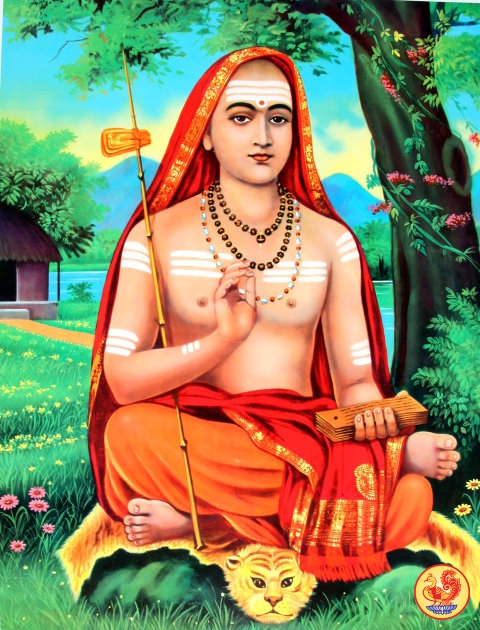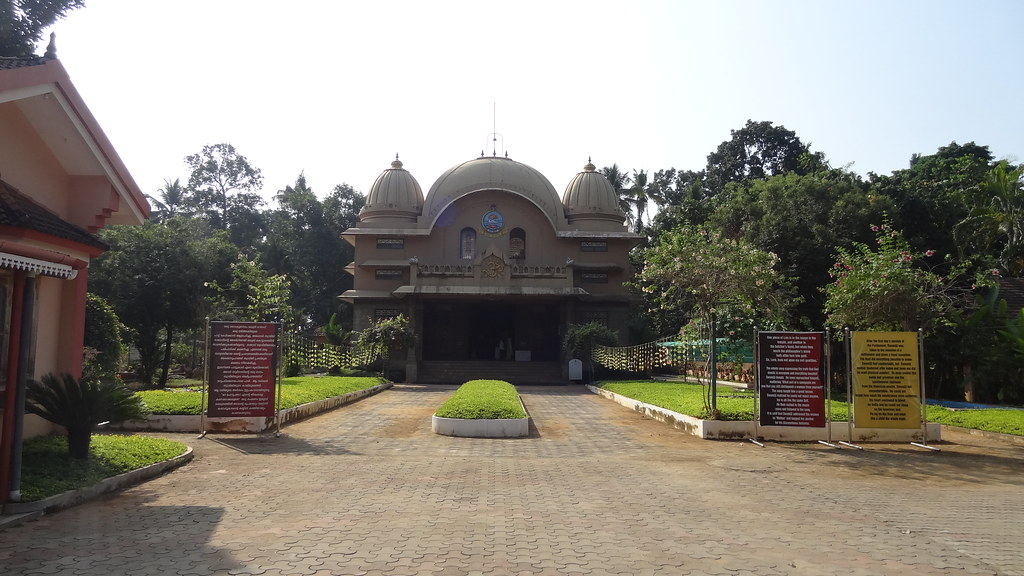After a gap of about more than two and a half years due to the corona (Covid 19) outbreak, I slowly restarted my spiritual journey, first by visiting our family deity - Kuladeivam Sri Mahadevar temple in Ettumanoor (in Kottayam district, Kerala) to take His Blessings. Though we followed our planned schedule for this pilgrimage, one place which we did not think of in our schedule suddenly flashed up in our mind, thanks to one of our relatives, as a bubble when we were in Ettumanoor. That was Kalady, the birth place of Sri Adi Sankaracharya. With no time to spare, a suggestive program was chalked out with our driver sarathy for visiting Kalady. In other words, the destiny drew us like a river flow to Adi Shankaracharya birth place - the Kalady. It was an experience beyond an imagination of an ordinary village side as we entered the devine place where thousands of years ago a baby's cry sphere headed the advent of a man who would show the world the path to liberation, a man would come to respect and admire as Jagadguru Adi Shankaracharya.
We started at 8.00 a.m. after finishing all our refreshments to cover up a distance of about 75 Km - 2 hrs travel in a van. With intermittent break-ups on the way, we reached Kalady past mid-day, by that time the temple was closed and we were waiting there for its reopen at 4.00 p.m.
Kaladi or Kalady is a tiny hamlet located near Aluva (22 KM) of Ernakulam district in Kerala, the nearest railway station being Angamali (8 KM) and the nearest airport being Kochi international airport (7 KM). Kalady in Malayalam language means 'footprint' which was once called as 'Sasalam'. Kalady was rediscovered and came into prominence late 19th century by the then Shankaracharya of Sringeri and subsequent consecration of a temple for Adi Shankaracharya in 1910.
Kalady is the Holy birth place of the great human alien and philosopher Adi Shankaracharya. Though born in the southern extremity of India in Kerala, Adi Shankaracharya travelled the length and breadth of India, not once or twice but thrice. What he achieved in his short life span of 32 years cannot be achieved in 32 lifetimes of any other gurumars. The place is blessed with many important temples including shrines dedicated to Sri Shankara, Sharda Devi, Sri Krishna and Sri Ramakrishna. Festival celebrations here are solemn events that attract believer in large numbers. Jagadguru of Adi Shankara Bhagavadpada, a pre-eminent center for inspiration on the banks of the Poorna river that purifies the mankind in thought, word and deed.

Jagadguru Shankaracharyas of Sringeri, Dwaraka. Badari and Puri jointly conveyed a message - "A visit to Kalady increases tranquility, self restraint and other eminent virtues of those engaged in the pursuit of knowledge.
It is the duty of every common man to visit the Holy Kalady, the birth place of Adi Shankara and more so for any aspirant for liberation, the sanyasi and those who follow the Advaita school of thought."
Kalady, the birth place of Sri Adi Sankaracharya during the 8th century. This place where Shankara was born and raised was unknown to us for several centuries. A 100 years ago, through the 33rd Jagadguru of the Sringeri Sharadha Peetam the first and the foremost institution established by Shri Adi Shankaracharya to convey His teachings brought about the change.
Kalady is also known as Adi Shankara Janma Bhumi Kshetram, on the banks of the Holy river Poorna (Periyar). He was a shining spiritual light, intellectual giant and a genius of linguistics, the level of wisdom and knowledge He showed at a very early age made him a shining light for humanity. He illuminated the land of Bharat with His teachings that are still as impactful as ever. He was a prodigal child and an extraordinary scholar with almost super human capabilities.
At the age of 2 - he could fluently speak & write Sanskrit,
at the age of 4 - could recite all the Vedas and
at the age of 12 - took sanyasa and left his home in Kalady.
He left his body at the age of 32. Between the age of 12 and 32 he travelled widely throughout the country.
 |
The historical legendary goes like this - Throughout the course of his early life, Shankara astounded many with his knowledge intelligence. He started writing his own analysis of the Upanishads, BrahmaSutra and the Bhagavad Gita at a young age. Right from his childhood, he was keen on becoming a monk or sanyasi. Adi Shankara's mother Aryaamba did not agree with his desire to become a monk. Legend says that one day, Shankara was touched by a dog and, as per custom followed by the community Shankara had to take a bath. Accompanied by mother, Shankara went to river Poorna to bathe. While in the water, a crocodile got hold of his leg. The drowning Shankara told his mother that the crocodile would leave him alone if she would allow him to take up sanyasa. Helpless mother Aryaamba agreed, and the crocodile freed Shankara. This place is even today called as '"Muthala Kadavu" or "Crocodile Ghat" where Shankara's life turned to sanyasa/monk.



His philosophical works include review of Brahma Sutra, commentaries on Bhagavad Gita, ten principal Upanishads, many stotras, poems praising gods & goddesses, and famous Upadesasahasri etc. An exhaustive list of all his works are given below, as seen in Vivekavani.
Even today, many scholars wonder how Acharya wrote so much in a very short lifespan of 32 years. Undoubtedly it shows that he was the greatest scholar and a man on a mission to teach & establish the philosophy of Advaita. Though the majority of his works concentrate on Advaita, he equally penned on bhakti since he believed that bhakti was a very essential step for Chiththa Shuddhi without which self-realisation was not possible. Hence he composed verses and hymns in praise of every lord, the majority of which were concentrated on Vishnu, Shiva, and Shakthi. He wanted the people to worship the lord in any form of their wish, the results of which must finally purify their mind and make it fit for self-realisation. From his life history, it is evident that he was blessed by Lord Narasimha, Goddess Saraswati, and Lord Vishvanatha. Hence one can find a true Vaishnava, Shaiva and Shakthi in him. The most highlighting factor is the baashya for Hastamalakeeyam written by Shri Shankaracharya since rarely a Guru has written baashya for the work of his own disciple. Below is the list of works by Shri Adi Shankaracharya which are widely accepted to be his works.
BHASHYA GRANTHAS
- Brahma Sutras
- Isavasya Upanishad
- Kena Upanishad
- Katha Upanishad
- Prasna Upanishad
- Mundaka Upanishad
- Mandukya Upanishad
- Mandukya Karika
- Aitareya Upanishad
- Taittiriya Upanishad
- Chandogya Upanishad
- Brihadaranyaka Upanishad
- Sree Nrisimha Taapaneeya Upanishad
- Bhagavad Gita
- Vishnu Sahasranama of
- Sanat Sujatheeyam
- Lalita Trishati
- Hastamalakeeyam
PRAKARANA GRANTHAS
- Vivekachudamani
- Aparokshanubhuti
- Upadesasahasri
- Vaakya Vritti
- Swatma Nirupanam
- Atma bodha
- Sarva Vedanta Sara Samgraha
- Prabodha Sudhakaram
- Swaatma Prakasika
- Advaita Anubhuti
- Brahma anuchintanam
- Prashnouttara Ratnamaalika
- Sadachara anusandhanam
- Yaga Taravali
- Anatmasree Vigarhanam
- Swaroopa anusandhanam
- Pancheekaranam
- Tattwa bodha
- Prouda anubhooti
- Brahma Jnanavali
- Laghu Vakyavritti
- Bhaja Govindam
- Prapancha Saaram
HYMNS AND MEDITATION VERSES
- Sri Ganesa Pancharatnam
- Ganesa Bhujangam
- Subrahmanya Bhujangam
- Siva Bhujangam
- Devi Bhujangam
- Bhavani Bhujangam
- Sree Rama Bhujangam
- Vishnu Bhujangam
- Sarada Bhujangam
- Sivananda Lahari
- Soundarya Lahari
- Ananda Lahari
- Sivapaadaadi kesaanta varnana
- Siva kesaadi padaanta varnana
- Sree Vishnu-paadaadi-kesanta
- Uma maheswara Stotram
- Tripurasundari Vedapada Stotram
- Tripurasundari Manasapooja
- Tripurasundari Ashtakam
- Devi shashti upachara-pooja
- Mantra matruka Pushpamaala
- Kanakadhara Stotram
- Annapoorna Stotram
- Ardhanareshwara Stotram
- Bhramanaamba Ashtakam
- Meenakshi Stotram
- Meenakshi Pancharatnam
- Gouri Dasakam
- Navaratna Malika
- Kalyana Vrishtistavam
- Lalitha Pancharatnam
- Maaya Panchakam
- Suvarna Mala Stuti
- Dasa Sloki
- Veda Sara Siva StotramHara
- Siva Panchaakshara Stotram
- Sivaaparadha Kshamapana
- Dakshinamoorthy Ashtakam
- Dakshinamoorthy Varnamala
- Mrutyunjaya Manasa Pooja Stotram
- Siva Namavali Ashtakam
- Kaala Bhairava Ashtakam
- Shatpadee Stotram
- Siva Panchakshara Nakshatra Mala
- Dwadasa Ling Stotram
- Kasi Panchakam
- Hanumat Pancharatnam
- Lakshmi-Nrisimha Pancharatnam
- Lakshmi-Nrisimha Karunarasa Stotram
- Panduranga Ashtakam
- Achyuta Ashtakam
- Sree Krishna Ashtakam
- Hari Stuti
- Govinda Ashtakam
- Bhagavat Manasa Pooja
- Praata Smarana Stotram
- Jagannatha Ashtakam
- Guruvashtakam
- Narmada Ashtakam
- Yamuna Ashtakam
- Ganga Ashtakam
- Manikarnika Ashtakam
- Nirguna Manasa Pooja
- Eka Sloki
- Yati Panchakam
- Jeevan Mukta Ananda Lahari
- Dhanya Ashtakam
- Upadesa (Sadhna) Panchakam
- Sata Sloki
- Maneesha Panchakam
- Advaita Pancharatnam
- Nirvana Shatakam
- Devyapara-dha kshamapa stotra
Courtesy: VivekaVani
Some of the other interesting and important places to visit in Kaladi are -
1. Shringeri Mutt
2. Sri Krishna Temple
3. Holy Crocodile Ghat
4. Sri Ramakrishna Advaita Ashram
This Ashram or Math in Kalady is a branch of the Ramakrishna Math & Ramakrishna Mission (HQ) of the Belur Math, West Bengal. Started in 1936 and made a branch centre of the Math in 1941. This math established Schools for Nursery, Junior Basic, Sanskrit Upper Primary, Secondary and Higher Secondary.

5. Sri Adi Shankara Keerthi Sthambha Mandapam established by Kanchi Kamakoti Peetam.
This is an eight-story memorial built by Kanchi Kamakoti Math. At the entrance, there are two elephant statues guarding the memorial. After entering you can see the Paduka Mandapam. From there, one can climb to the eight story through well laid easily climbable circular steps. While climbing up one can witness enjoy the paintings, beautiful goddess scilptures on the side walls as well as in the centre portion along with adi shankara life history - a very rare feast to the eyes.
After a devineful and blissful darshan and with hearty contentment , we headed to visit another important place in our schedule - i.e. Chotanikara Sri Bhagavwati Amman temple.







